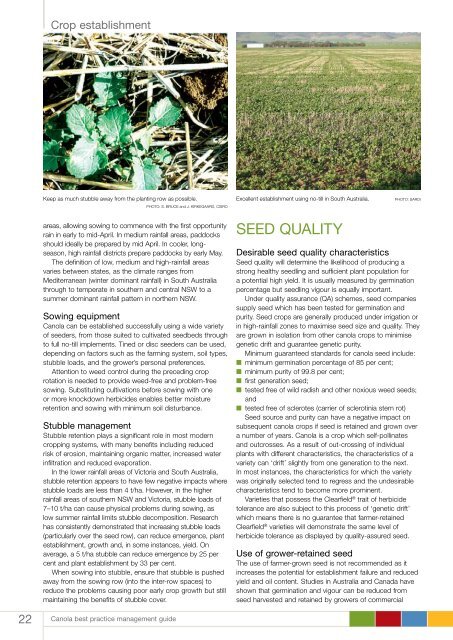best practice management guide for south-eastern Australia - Grains ...
best practice management guide for south-eastern Australia - Grains ...
best practice management guide for south-eastern Australia - Grains ...
Create successful ePaper yourself
Turn your PDF publications into a flip-book with our unique Google optimized e-Paper software.
Crop establishment<br />
Keep as much stubble away from the planting row as possible.<br />
<br />
Photo: S. Bruce and J. Kirkegaard, CSIRO<br />
Excellent establishment using no-till in South <strong>Australia</strong>. <br />
Photo: SARDI<br />
areas, allowing sowing to commence with the first opportunity<br />
rain in early to mid-April. In medium rainfall areas, paddocks<br />
should ideally be prepared by mid April. In cooler, longseason,<br />
high rainfall districts prepare paddocks by early May.<br />
The definition of low, medium and high-rainfall areas<br />
varies between states, as the climate ranges from<br />
Mediterranean (winter dominant rainfall) in South <strong>Australia</strong><br />
through to temperate in <strong>south</strong>ern and central NSW to a<br />
summer dominant rainfall pattern in northern NSW.<br />
Sowing equipment<br />
Canola can be established successfully using a wide variety<br />
of seeders, from those suited to cultivated seedbeds through<br />
to full no-till implements. Tined or disc seeders can be used,<br />
depending on factors such as the farming system, soil types,<br />
stubble loads, and the grower’s personal preferences.<br />
Attention to weed control during the preceding crop<br />
rotation is needed to provide weed-free and problem-free<br />
sowing. Substituting cultivations be<strong>for</strong>e sowing with one<br />
or more knockdown herbicides enables better moisture<br />
retention and sowing with minimum soil disturbance.<br />
Stubble <strong>management</strong><br />
Stubble retention plays a significant role in most modern<br />
cropping systems, with many benefits including reduced<br />
risk of erosion, maintaining organic matter, increased water<br />
infiltration and reduced evaporation.<br />
In the lower rainfall areas of Victoria and South <strong>Australia</strong>,<br />
stubble retention appears to have few negative impacts where<br />
stubble loads are less than 4 t/ha. However, in the higher<br />
rainfall areas of <strong>south</strong>ern NSW and Victoria, stubble loads of<br />
7–10 t/ha can cause physical problems during sowing, as<br />
low summer rainfall limits stubble decomposition. Research<br />
has consistently demonstrated that increasing stubble loads<br />
(particularly over the seed row), can reduce emergence, plant<br />
establishment, growth and, in some instances, yield. On<br />
average, a 5 t/ha stubble can reduce emergence by 25 per<br />
cent and plant establishment by 33 per cent.<br />
When sowing into stubble, ensure that stubble is pushed<br />
away from the sowing row (into the inter-row spaces) to<br />
reduce the problems causing poor early crop growth but still<br />
maintaining the benefits of stubble cover.<br />
Seed quality<br />
Desirable seed quality characteristics<br />
Seed quality will determine the likelihood of producing a<br />
strong healthy seedling and sufficient plant population <strong>for</strong><br />
a potential high yield. It is usually measured by germination<br />
percentage but seedling vigour is equally important.<br />
Under quality assurance (QA) schemes, seed companies<br />
supply seed which has been tested <strong>for</strong> germination and<br />
purity. Seed crops are generally produced under irrigation or<br />
in high-rainfall zones to maximise seed size and quality. They<br />
are grown in isolation from other canola crops to minimise<br />
genetic drift and guarantee genetic purity.<br />
Minimum guaranteed standards <strong>for</strong> canola seed include:<br />
n minimum germination percentage of 85 per cent;<br />
n minimum purity of 99.8 per cent;<br />
n first generation seed;<br />
n tested free of wild radish and other noxious weed seeds;<br />
and<br />
n tested free of sclerotes (carrier of sclerotinia stem rot)<br />
Seed source and purity can have a negative impact on<br />
subsequent canola crops if seed is retained and grown over<br />
a number of years. Canola is a crop which self-pollinates<br />
and outcrosses. As a result of out-crossing of individual<br />
plants with different characteristics, the characteristics of a<br />
variety can ‘drift’ slightly from one generation to the next.<br />
In most instances, the characteristics <strong>for</strong> which the variety<br />
was originally selected tend to regress and the undesirable<br />
characteristics tend to become more prominent.<br />
Varieties that possess the Clearfield ® trait of herbicide<br />
tolerance are also subject to this process of ‘genetic drift’<br />
which means there is no guarantee that farmer-retained<br />
Clearfield ® varieties will demonstrate the same level of<br />
herbicide tolerance as displayed by quality-assured seed.<br />
Use of grower-retained seed<br />
The use of farmer-grown seed is not recommended as it<br />
increases the potential <strong>for</strong> establishment failure and reduced<br />
yield and oil content. Studies in <strong>Australia</strong> and Canada have<br />
shown that germination and vigour can be reduced from<br />
seed harvested and retained by growers of commercial<br />
22 Canola <strong>best</strong> <strong>practice</strong> <strong>management</strong> <strong>guide</strong>

















